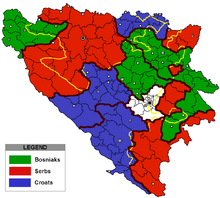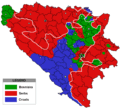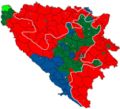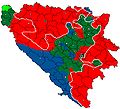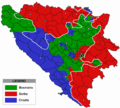- Croat–Bosniak War
-
Croat-Bosniak War Part of the Bosnian War 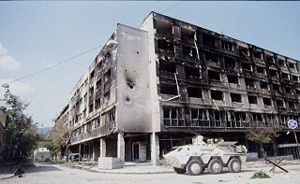
A war ravaged street in Mostar caused by Bosniak-Croat fightingDate June 19, 1992 – February 23, 1994 Location Bosnia and Herzegovina, particularly in Central Bosnia and along the Neretva river Result Stalemate, Washington Agreement and creation of the Federation of Bosnia and Herzegovina Territorial
changesPrior to the war the HVO controlled more than 20 percent of the territory of Bosnia and Herzegovina but at the signing of the Washington agreement less than 10 percent.[1] Belligerents  Herzeg-Bosnia
Herzeg-Bosnia
 Croatia
Croatia Republic of
Republic of
Bosnia and Herzegovina
Commanders and leaders  Franjo Tuđman (President of Croatia)
Franjo Tuđman (President of Croatia)
 Mate Boban
Mate Boban
(President of the Croatian Republic of Herzeg-Bosnia) Milivoj Petković
Milivoj Petković
(HVO Chief of staff) Dario Kordić
Dario Kordić
(political leader of Croats in central Bosnia) Valentin Ćorić
Valentin Ćorić
(commander, HVO military police) Alija Izetbegović
Alija Izetbegović
(President of the Republic of Bosnia and Herzegovina) Sefer Halilović
Sefer Halilović
(ARBiH chief of staff 1992-1993) Rasim Delić
Rasim Delić
(ARBiH chief of staff 1993-1995) Arif Pašalić
Arif Pašalić
(commander, IV Corps ARBiH)
 Blaž Kraljević †
Blaž Kraljević †
(commander, Croatian Defence Forces)The Croat–Bosniak War was a conflict between the Republic of Bosnia and Herzegovina and the self-proclaimed Croatian Community of Herzeg-Bosnia supported by the Republic of Croatia, that lasted from June 19, 1992[3] – February 23, 1994. The ICTY effectively determined the war's nature to be international between Croatia and Bosnia and Herzegovina in numerous verdicts against Croat political and military leaders.[4] The Croat-Bosniak war is often referred to as the war in a war because it was part of the larger Bosnian War.
There are no precise statistics dealing with the casualties of the Croat-Bosniak conflict along ethnic lines. The Sarajevo-based Research and Documentation Center's (IDC) data from 2007 on human losses in the regions caught in the Croat-Bosniak conflict as part of the wider Bosnian War, however, can serve as a rough approximation. According to this data, in Central Bosnia most of the 10,448 documented casualties (soldiers and civilians) were Bosniaks (62%), with Croats in second (24%) and Serbs (13%) in third place. The municipalities of Gornji Vakuf-Uskoplje and Bugojno also geographically located in Central Bosnia (known as Gornje Povrbasje region), with the 1,337 documented casualties are not included in Central Bosnia statistics, but in Vrbas region statistics. Approximately 70-80% of the casualties from Gornje Povrbasje were Bosniaks. In the region of Neretva river of 6,717 casualties, 54% were Bosniaks, 24% Serbs and 21% Croats. The casualties in those regions were mostly but not exclusively the consequence of Croat-Bosniak conflict. To a lesser extent the conflict with the Serbs also resulted in a number of casualties included in the statistics.[5]
Contents
Background
Main article: War in Bosnia and HerzegovinaDuring the Yugoslav wars, the objectives of nationalists from Croatia were shared by Croat nationalists in Bosnia and Herzegovina.[6] The ruling party in the Republic of Croatia, the Croatian Democratic Union (HDZ), organized and controlled the branch of the party in Bosnia and Herzegovina. By the latter part of 1991, the more extreme elements of the party, under the leadership of Mate Boban, Dario Kordić, Jadranko Prlić, Ignac Koštroman and local leaders such as Anto Valenta[6], and with the support of Franjo Tuđman and Gojko Šušak, had taken effective control of the party.
Following the declaration of independence, the Serbs attacked different parts of Bosnia and Herzegovina. The state administration of Bosnia and Herzegovina effectively ceased to function having lost control over the entire territory. The Croats and their leader Franjo Tuđman also aimed at securing parts of Bosnia and Herzegovina as Croatian. Secret discussions between Franjo Tuđman and Slobodan Milošević on the division of Bosnia and Herzegovina were held as early as March 1991 known as the Karađorđevo agreement. The policies of the Republic of Croatia and its leader Franjo Tuđman towards Bosnia and Herzegovina were never totally transparent and always included Franjo Tuđman’s ultimate aim of expanding Croatia’s borders.[7]
On November 18, 1991, the party branch in Bosnia and Herzegovina, proclaimed the existence of the Croatian Community of Herzeg-Bosnia, as a separate "political, cultural, economic and territorial whole," on the territory of Bosnia and Herzegovina.[8]
The ICTY illustrated this with the minutes of a meeting held on November 12, 1991 and signed by Mate Boban and Dario Kordić: "the Croatian people in Bosnia and Herzegovina must finally embrace a determined and active policy which will realise our eternal dream – a common Croatian state". On April 10, 1992, Mate Boban decreed that the Bosnian Territorial Defence (TO), which had been created the day before, was illegal on self-proclaimed Croat territory. On May 11, Tihomir Blaškić declared the TO illegal on the territory of the Kiseljak municipality.[6]
In June 1992 the focus switched to Novi Travnik and Gornji Vakuf where the Croat Defence Council (HVO) efforts to gain control were resisted. On June 18, 1992 the Bosnian Territorial Defence in Novi Travnik received an ultimatum from the HVO which included demands to abolish existing Bosnia and Herzegovina institutions, establish the authority of the Croatian Community of Herzeg-Bosnia and pledge allegiance to it, subordinate the Territorial Defense to the HVO and expel Muslim refugees, all within 24 hours. The attack was launched on June 19. The elementary school and the Post Office were attacked and damaged.[3] Gornji Vakuf was initially attacked by Croats on June 20, 1992, but the attack failed.[citation needed] The Graz agreement caused deep division inside the Croat community and strengthened the separation group, which led to the conflict with Bosniaks. Armed incidents started to occur among Croats in Bosnia and Herzegovina in the summer of 1992 between the HVO and the HOS.[9] The HVO favoured an ethnic partition of the republic while the HOS fought together with the Muslims for the territorial integrity of the state.[9] One of the primary pro-union Croat leaders, Blaž Kraljević (leader of the HOS armed group) was killed by HVO soldiers in August 1992, leading to the dissolution of the primary group in support of a Bosniak-Croat alliance.[9] The situation became more serious in October 1992 when Croat forces attacked Bosniak civilian population in Prozor burning their homes and killing civilians. According to Jadranko Prlić indictment, HVO forces cleansed most of the Muslims from the town of Prozor and several surrounding villages.[8]
By December 1992, much of Central Bosnia was in the hands of the Croats. The Croat forces had taken control of the municipalities of the Lašva Valley and had only met significant opposition in Novi Travnik and Ahmići.[10]
The ICTY Trial Chamber in the Kordić and Čerkez case decided that the weight of the evidence points clearly to the persecution of Bosniak civilians in the Central Bosnian municipalities taken over by the Croat forces: Busovača, Novi Travnik, Vareš, Kiseljak, Vitez, Kreševo and Žepče. The persecution followed a consistent pattern in each municipality and demonstrated that the HVO had launched a campaign against the Bosniaks in them [11] with the hope that the self-proclaimed Croatian Community of Herzeg-Bosnia should secede from Bosnia and Herzegovina and with a view towards unification with Croatia.[12]
Up till 1993 the HVO and the Bosnian Army (ARBiH) had been fighting side by side against the Army of Republika Srpska (VRS) in some areas of Bosnia and Herzegovina. Even though armed confrontation and events like the Totić kidnappings strained the relationship between the HVO and ARBiH the Croat-Bosniak alliance held in Bihać pocket (northwest Bosnia) and the Bosanska Posavina (north), where both were heavily outmatched by Serb forces.
Chronology
Main article: Chronology of the Croat-Bosniak warGornji Vakuf shelling
On January 1993 Croat forces attacked Gornji Vakuf again in order to connect Herzegovina with Central Bosnia.[8] Gornji Vakuf is a town to the south of the Lašva Valley and of strategic importance at a crossroads en route to Central Bosnia. It is 48 kilometres from Novi Travnik and about one hour’s drive from Vitez in an armoured vehicle. For Croats it was a very important connection between the Lašva Valley and Herzegovina, two territories included in the self-proclaimed Croatian Community of Herzeg-Bosnia. The Croat forces shelling reduced much of the historical oriental center of the town of Gornji Vakuf to rubble.[13]
On January 10, 1993, just before the outbreak of hostilities in Gornji Vakuf, the Croat Defence Council (HVO) commander Luka Šekerija, sent a "Military – Top Secret" request to Colonel Tihomir Blaškić and Dario Kordić, (later convicted by ICTY of war crimes and crimes against humanity i.e. ethnic cleansing) for rounds of mortar shells available at the ammunition factory in Vitez.[14] Fighting then broke out in Gornji Vakuf on January 11, 1993, sparked by a bomb which had been placed by Croats in a Bosniak-owned hotel that had been used as a military headquarters. A general outbreak of fighting followed and there was heavy shelling of the town that night by Croat artillery.[13]
During cease-fire negotiations at the Britbat HQ in Gornji Vakuf, colonel Andrić, representing the HVO, demanded that the Bosnian forces lay down their arms and accept HVO control of the town, threatening that if they did not agree he would flatten Gornji Vakuf to the ground.[13][15] The HVO demands were not accepted by the Bosnian Army and the attack continued, followed by massacres on Bosnian Muslim civilians in the neighbouring villages of Bistrica, Uzričje, Duša, Ždrimci and Hrasnica.[16][17] During the Lašva Valley ethnic cleansing it was surrounded by Croatian Army and Croatian Defence Council for seven months and attacked with heavy artillery and other weapons (tanks and snipers). Although Croats often cited it as a major reason for the attack on Gornji Vakuf, the commander of the British Britbat company claimed that there were no Muslim holy worriors in Gornji Vakuf (commonly known as Mujahideen) and that his soldiers did not see any. The shelling campaign and the attackes during the war resulted in hundreds of injured and killed, mostly Bosnian Muslim civilians.[13]
On the morning of January 25, 1993, Croat forces attacked the Bosniak part of the town of Busovača called Kadića Strana following the January 20 ultimatum. The attack included shelling from the surrounding hills. A loudspeaker called on Bosniaks to surrender. A police report shows that 43 people were massacred in Busovača in January and February 1993. The remaining Bosniaks (around 90 in all) were rounded up in the town square. Women and children (around 20 in total) were allowed to return home and the men (70 in all), some as young as 14–16 years, were loaded onto buses and taken to Kaonik camp. The violence continued after the January attack.[18]
Lašva Valley ethnic cleansing
Main article: Lašva Valley ethnic cleansingThe Lašva Valley ethnic cleansing campaign against Bosniak civilians planned by the Croatian Community of Herzeg-Bosnia's political and military leadership from May 1992 to March 1993 and erupting the following April, was meant to implement objectives set forth by Croat nationalists in November 1991.[6] The Lašva Valley's Bosniaks were subjected to persecution on political, racial and religious grounds[19], deliberately discriminated against in the context of a widespread attack on the region's civilian population[20] and suffered mass murder, rape, imprisonment in camps, as well as the destruction of cultural sites and private property. This was often followed by anti-Bosniak propaganda, particularly in the municipalities of Vitez, Busovača, Novi Travnik and Kiseljak. Ahmići massacre in April 1993, was the culmination of the Lašva Valley ethnic cleansing, resulting in mass killing of Bosnian Muslim civilians in just a few hours. An estimate puts the death toll at 120. The youngest was a three-month-old baby, who was machine-gunned to death in his crib, and the oldest was a 96-year-old woman.[citation needed] It is the biggest massacre committed during the conflict between Croats and the Bosnian government.
The International Criminal Tribunal for the Former Yugoslavia (ICTY) has ruled that these crimes amounted to crimes against humanity in numerous verdicts against Croat political and military leaders and soldiers, most notably Dario Kordić.[21] Based on the evidence of numerous HVO attacks at that time, the ICTY Trial Chamber concluded in the Kordić and Čerkez case that by April 1993 Croat leadership had a common design or plan conceived and executed to ethnically cleanse Bosniaks from the Lašva Valley. Dario Kordić, as the local political leader, was found to be the planner and instigator of this plan.[22] According to the Sarajevo-based Research and Documentation Center (IDC), around 2,000 Bosniaks from the Lašva Valley are missing or were killed during this period.[23] The events inspired the British television drama serial Warriors.
War in Herzegovina
The Croatian Community of Herzeg-Bosnia took control of many municipal governments and services in Herzegovina as well, removing or marginalising local Bosniak leaders. Herzeg-Bosnia took control of the media and imposed Croatian ideas and propaganda. Croatian symbols and currency were introduced, and Croatian curricula and the Croatian language were introduced in schools. Many Bosniaks and Serbs were removed from positions in government and private business; humanitarian aid was managed and distributed to the Bosniaks' and Serbs' disadvantage; and Bosniaks in general were increasingly harassed. Many of them were deported into concentration camps: Heliodrom, Dretelj, Gabela, Vojno and Šunje.[24][21][not in citation given]
According to ICTY judgment in Naletilić-Martinović case Croat forces attacked the villages of Sovici and Doljani, about 50 kilometres (31 mi) north of Mostar in the morning on April 17, 1993. The attack was part of a larger HVO offensive aimed at taking Jablanica, the main Bosnian Muslim dominated town in the area. The HVO commanders had calculated that they needed two days to take Jablanica. The location of Sovici was of strategic significance for the HVO as it was on the way to Jablanica. For the Bosnian Army it was a gateway to the plateau of Risovac, which could create conditions for further progression towards the Adriatic coast. The larger HVO offensive on Jablanica had already started on April 15, 1993. The artillery destroyed the upper part of Sovici. The Bosnian Army was fighting back, but at about five p.m. the Bosnian Army commander in Sovici, surrendered. Approximately 70 to 75 soldiers surrendered. In total, at least 400 Bosnian Muslim civilians were detained. The HVO advance towards Jablanica was halted after a cease-fire agreement had been negotiated.[25]
Siege of Mostar
Mostar was surrounded by the Croat forces for nine months, and much of its historic city was severely destroyed in shelling including the famous Stari Most bridge.[26] Slobodan Praljak, the commander of the Croatian Defence Council, is currently on trial at the ICTY for ordering the destruction of the bridge, among other charges.[26]
Mostar was divided into a Western part, which was dominated by the Croat forces and an Eastern part where the Army of Republic of Bosnia and Herzegovina was largely concentrated. However, the Bosnian Army had its headquarters in West Mostar in the basement of a building complex referred to as Vranica. In the early hours of May 9, 1993, the Croatian Defence Council attacked Mostar using artillery, mortars, heavy weapons and small arms. The HVO controlled all roads leading into Mostar and international organisations were denied access. Radio Mostar announced that all Bosniaks should hang out a white flag from their windows. The HVO attack had been well prepared and planned.[27]
The Croats took over the west side of the city and expelled thousands[26] Bosniaks from the west side into the east side of the city. The HVO shelling reduced much of the east side of Mostar to rubble. The JNA (Yugoslav Army) demolished Carinski Bridge, Titov Bridge and Lucki Bridge over the river excluding the Stari Most. HVO forces (and its smaller divisions) engaged in a mass execution, ethnic cleansing and rape on the Bosniak people of the West Mostar and its surrounds and a fierce siege and shelling campaign on the Bosnian Government run East Mostar. HVO campaign resulted in thousands of injured and killed.[26]
The June 1993 Offensives
In June 1993 further fighting broke out in Central Bosnia, some of it caused by the newly revitalised Bosnian Army.[28] Further complications were caused with the incident between Croats and UNPROFOR known as The Convoy of Joy Incident. This convoy of aid supplies was made up of several hundred trucks, was seven kilometres in length and was bound for Tuzla. On June 7, 1993, two members of the delegation wrote to the European Community Monitor Mission (ECMM) at Zenica about their fears for the safety of the convoy when it reached the area of Travnik and Vitez in the light of threats made to it by Mate Boban (whom the delegation had met). As a result the ECMM decided to monitor the convoy. The convoy then made its way to Central Bosnia and the area of Novi Travnik. There it was stopped at a roadblock formed by a large crowd of Croat women at Rankovići, north of Novi Travnik. Eight of the drivers were shot and killed, vehicles were driven away and the convoy was looted by civilians and soldiers. Eventually the convoy was released. In defending the convoy Britbat shot and killed two HVO soldiers. The ICTY Trial Chamber concluded that the crowds which stopped the Convoy of Joy were under the control of Dario Kordić and colonel Blaškić.[29]
Bosnian Army attacked the HVO in the Travnik municipality in the first week of June. By June 13, the Bosnian Army had taken Travnik and the surrounding villages.[30] Several witnesses testified that 20,000 Croat refugees had come from Travnik as a result of the Bosnian Army offensive.[29] However, according to an ECMM Report the first reports of ethnic cleansing and destruction were exaggerated. On June 8, there was fighting in Guča Gora with reports of atrocities and destruction, the Catholic church in flames and thousands fleeing. These reports were investigated by two ECMM monitors. They found the church still standing and the claims of destruction to be exaggerated. The movement of population was organised by the HVO. According to report dated June 9, 1993 it is the first time that the Bosnian Army have taken the military initiative against the HVO in Central Bosnia. On all other occasions the Bosnian Army have responded to HVO aggression (Gornji Vakuf, Vitez and Mostar).[30]
On June 9, 1993 HVO retaliated in Novi Travnik.[31] On June 12-13, 1993 the HVO attacked villages in the Kiseljak municipality, beginning with Tulica on June 12 resulting in the deaths of at least twelve men and women and the destruction of the village. The attack began with heavy shelling of the village followed by an infantry attack from several directions. The surviving men were loaded onto a truck and taken to Kiseljak barracks. Shortly after the attack on Tulica, the associated villages of Han Ploča and Grahovci were also subject to attack. The HVO issued an ultimatum to the Bosniaks to surrender their weapons. After the ultimatum expired, the village was shelled by the HVO and the Serb Army, and houses were set on fire. An HVO infantry attack followed. Having come into the village, HVO soldiers lined up three Bosniak men against a wall and shot them. In all 64 people were killed during the attack or after HVO capture. The ICTY Trial Chamber found that the attacks on Tulica and Han Ploca–Grahovci were part of a sustained HVO attack in which civilians were murdered and subjected to inhumane treatment.[32]
The Remaining Offensives
Bosnian Army launched an operation known as Neretva 93 against the Croatian Defence Council and Croatian Army in September 1993 in order to end the siege of Mostar and to recapture areas of Herzegovina, which were included in self-proclaimed Croatian Republic of Herzeg-Bosnia. The operation was stopped by Bosnian authorities after it received the information about the massacre on Croat civilians in the village of Grabovica and very difficult fight for the village of Uzdol which resulted in losses on both sides.
The entire conflict caused the creation of more ethnic enclaves and further bloodshed in the already war-ruined Bosnia. The conflict was particularly devastating for Mostar and Gornji Vakuf.
War ends
The Croat-Bosniak war officially ended on February 23, 1994 when the Commander of HVO, general Ante Roso and commander of Bosnian Army, general Rasim Delić, signed a ceasefire agreement in Zagreb. In March 1994 a peace agreement mediated by the USA between the warring Croats (represented by Republic of Croatia) and Bosnia and Herzegovina was signed in Washington and Vienna which is known as the Washington Agreement. Under the agreement, the combined territory held by the Croat and Bosnian government forces was divided into ten autonomous cantons, establishing the Federation of Bosnia and Herzegovina. In the start of the war the HVO controlled more than 20 percent of the territory of Bosnia and Herzegovina; however, just before the signing of the Washington agreement it was less than 10 percent.[1]
The Croat leadership (Jadranko Prlić, Bruno Stojić, Slobodan Praljak, Milivoj Petković, Valentin Ćorić and Berislav Pušić) is presently on trial at the ICTY on charges including crimes against humanity, grave breaches of the Geneva conventions and violations of the laws or customs of war. Dario Kordić, political leader of Croats in Central Bosnia was convicted of the crimes against humanity in Central Bosnia i.e. ethnic cleansing and sentenced to 25 years in prison.[21] Bosnian commander Sefer Halilović was charged with one count of violation of the laws and customs of war on the basis of superior criminal responsibility of the incidents during Operation Neretva '93 and found not guilty.[33]
Croatia's Regret
Croatia's president Ivo Josipović made an official visit to Bosnia in April 2010 during which he expressed a "deep regret" for Croatia's involvement in efforts to divide Bosnia and Herzegovina in the 1990s, resulting in the Croat-Bosniak war and suffering for many people on both sides.[34]
Gallery
-
The front lines in 1994, at the end of the Bosniak-Croat war and after the signing of the Washington Agreement
-
The front lines in 1995, before Operation Storm
-
The front lines in 1995, before the Dayton Agreement
External links
- The war in Croatia and Bosnia-Herzegovina, 1991-1995 - by Branka Magaš, Ivo Žanić, Noel Malcolm
- James Mason, photographs: War in Central Bosnia
- ICTY: Prlić et al. Initial Indictment - The Joint Criminal Enterprise (Herzeg-Bosnia case)
- ICTY: Initial indictment for the ethnic cleansing of the Lasva Valley area - Part I
- ICTY: Initial indictment for the ethnic cleansing of the Lasva Valley area - Part II
- ICTY: Kordić and Čerkez verdict
- ICTY: Blaškić verdict
- ICTY: Aleksovski verdict
- ICTY: Miroslav Bralo verdict
- ICTY: Naletilic and Martinovic verdict
- HRW: Conflict between Bosnia and Herzegovina and Croatia
- United States Institute of Peace: Washington Agreement
- Institute for War & Peace Reporting - Plan to Divide Bosnia Revealed
- The Court of Bosnia and Herzegovina: Paško Ljubičić indictment
- The Court of Bosnia and Herzegovina: Krešo Lučić indictment
- arhivcroTV (Croatian) (English)
Related films
- Warriors at the Internet Movie Database
- The Death of Yugoslavia at the Internet Movie Database - Part III. The Struggle for Bosnia
References
- ^ a b Magaš, Branka; Žanić, Ivo (2001). The War in Croatia and Bosnia-Herzegovina 1991-1995. Taylor & Francis. p. 66.
- ^ "IT-98-34-T, the Prosecutor versus Naletilic and Martinovic". ICTY. 17 July 2002. http://www.icty.org/x/cases/naletilic/trans/en/020717ED.htm. Retrieved 2007-09-25.
- ^ a b ICTY - Kordic and Cerkez judgment - II. PERSECUTION: THE HVO TAKE-OVERS B. Novi Travnik - [1]
- ^ "ICTY: Conflict between Bosnia and Croatia". http://hrw.org/reports/2004/ij/icty/2.htm#_Toc62882594.
- ^ RDC - Research results (2007) - Human Losses in Bosnia and Herzegovina 1991-1995 [2]
- ^ a b c d "ICTY: Blaškić verdict - A. The Lasva Valley: May 1992 – January 1993t". http://www.icty.org/x/cases/blaskic/tjug/en/bla-tj000303e.pdf.
- ^ "ICTY: Naletilić and Martinović verdict - A. Historical background". http://www.icty.org/x/cases/naletilic_martinovic/tjug/en/nal-tj030331-e.pdf.
- ^ a b c "ICTY: Prlić et al. (IT-04-74)". http://www.icty.org/x/cases/prlic/cis/en/cis_prlic_al_en.pdf.
- ^ a b c Lukic, Rénéo; Lynch, Allen (1996). Europe From the Balkans to the Urals: The Disintegration of Yugoslavia and the Soviet Union. Oxford University Press. pp. 212, 215. ISBN 0198292007.
- ^ "ICTY: Kordić and Čerkez verdict - III. Events leading to the conflict". http://www.icty.org/x/cases/kordic_cerkez/tjug/en/kor-tj010226e.pdf.
- ^ "ICTY: Kordić and Čerkez verdict - II. Persecution: F. Trial Chamber Findings". http://www.icty.org/x/cases/kordic_cerkez/tjug/en/kor-tj010226e.pdf.
- ^ "ICTY: Kordić and Čerkez verdict - E. The Parties’ Cases and Trial Chamber Findings". http://www.icty.org/x/cases/kordic_cerkez/tjug/en/kor-tj010226e.pdf.
- ^ a b c d "ICTY: Kordić and Čerkez verdict - IV. Attacks on towns and villages: killings - 2. The Conflict in Gornji Vakuf". http://www.icty.org/x/cases/kordic_cerkez/tjug/en/kor-tj010226e.pdf.
- ^ "ICTY: Kordić and Čerkez verdict - IV. Attacks on towns and villages: killings - 4. Role of Dario Kordić". http://www.icty.org/x/cases/kordic_cerkez/tjug/en/kor-tj010226e.pdf.
- ^ "SENSE Tribunal: Poziv na predaju". http://www.sense-agency.com/ba/stream.php?sta=3&pid=8670&kat=6.
- ^ "SENSE Tribunal: Ko je počeo rat u Gornjem Vakufu". http://www.sense-agency.com/ba/stream.php?sta=3&pid=8652&kat=6.
- ^ "SENSE Tribunal: "James Dean" u Gornjem Vakufu". http://www.sense-agency.com/ba/stream.php?sta=3&pid=8662&kat=6.
- ^ "ICTY: Kordić and Čerkez verdict - ICTY: Kordić and Čerkez verdict - IV. Attacks on towns and villages: killings - Busovača". http://www.icty.org/x/cases/kordic_cerkez/tjug/en/kor-tj010226e.pdf.
- ^ "ICTY (1995): Initial indictment for the ethnic cleansing of the Lasva Valley area - Part II". http://www.haverford.edu/relg/sells/indictments/Kordic2.html.
- ^ "ICTY: Summary of sentencing judgement for Miroslav Bralo". http://www.un.org/icty/bralo/bra-sum051207-e.htm.
- ^ a b c "ICTY: Kordić and Čerkez verdict". http://www.icty.org/x/cases/kordic_cerkez/tjug/en/kor-tj010226e.pdf.
- ^ "ICTY: Kordić and Čerkez verdict - IV. Attacks on towns and villages: killings - C. The April 1993 Conflagration in Vitez and the Lašva Valley - 3. The Attack on Ahmići (Paragraph 642)". http://www.icty.org/x/cases/kordic_cerkez/tjug/en/kor-tj010226e.pdf.
- ^ "IDC: Victim statistics in Novi Travnik, Vitez, Kiseljak and Busovača". http://www.idc.org.ba/aboutus/Overview_of_jobs_according_to_%20centers.htm.
- ^ "ICTY: Blaškić verdict". http://www.icty.org/x/cases/blaskic/tjug/en/bla-tj000303e.pdf.
- ^ ICTY (Naletilic-Matinovic): 1. Sovici and Doljani- the attack on 17 April 1993 and the following days [3]
- ^ a b c d "ICTY: Prlić et al. (IT-04-74)". http://www.icty.org/x/cases/prlic/cis/en/cis_prlic_al_en.pdf.
- ^ "ICTY: Naletilić and Martinović verdict - Mostar attack". http://www.icty.org/x/cases/naletilic_martinovic/tjug/en/nal-tj030331-e.pdf.
- ^ Kordic and Cerkez verdict - IV. ATTACKS ON TOWNS AND VILLAGES: KILLINGS - D. The June and October Offensives - [4]
- ^ a b Kordic and Cerkez verdict - IV. ATTACKS ON TOWNS AND VILLAGES: KILLINGS - D. The June and October Offensives - 1. The Convoy of Joy - [5]
- ^ a b ICTY - Kordic and Cerkez judgment - 2. The Conflict in Travnik and Zenica - [6]
- ^ ICTY - Kordic and Cerkez judgment - 3. The HVO Offensives in June 1993 - (a) Novi Travnik [7]
- ^ ICTY - Kordic and Cerkez judgment - 3. The HVO Offensives in June 1993 - (b) Tulica and Han Ploca–Grahovci [8]
- ^ Sefer Halilović - Judgement
- ^ "Josipovic apologizes for Croatia´s role in war in Bosnia". Croatian Times. April 15, 2010. http://www.croatiantimes.com/news/General_News/2010-04-15/10325/Josipovic_apologizes_for_Croatia%B4s_role_in_war_in_Bosnia.
Bosnian War Timeline 19911992 Serbian Republic of Bosnia and Herzegovina ·
Serbian Republic of Bosnia and Herzegovina ·  Republic of Bosnia and Herzegovina · Siege of Sarajevo · Siege of Bihać · Graz agreement · Croat–Bosniak War · Operation Vrbas '92 · Operation Corridor1993Kravica attack · Siege of Gornji Vakuf · Siege of Mostar · Operation Neretva '93 ·
Republic of Bosnia and Herzegovina · Siege of Sarajevo · Siege of Bihać · Graz agreement · Croat–Bosniak War · Operation Vrbas '92 · Operation Corridor1993Kravica attack · Siege of Gornji Vakuf · Siege of Mostar · Operation Neretva '93 · Autonomous Province of Western Bosnia · Operation Deny Flight19941995
Autonomous Province of Western Bosnia · Operation Deny Flight19941995War Crimes Ethnic cleansingAhatovići · Ahmići · Bijeljina · Biljani · Čemerno · Doboj · Dobrinja · Doljani · Duša · Foča · Glogova · Grabovica · Kiseljak · Korićani Cliffs · Kravica · Lašva Valley · Makljen · Markale · Mokronoge · Prijedor · Prozor · Raštani · Srebrenica · Stolac · Stupni Do · Štrpci · Tuzla · Višegrad (Barimo, Bosanska Jagodina, Paklenik, Sjeverin) · Vlasenica · Vrbanja · Zaklopača · ZvornikCampsCasesCategories:- Conflicts in 1992
- Conflicts in 1993
- Conflicts in 1994
- Bosnian War
- Civil wars involving the states and peoples of Europe
- Wars involving Croatia
Wikimedia Foundation. 2010.

